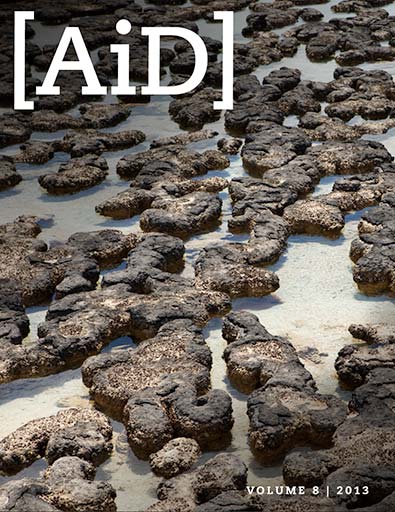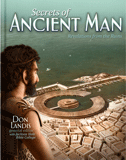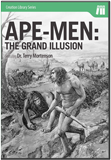
Does the Dmanisi Discovery Demonstrate We Are All One Family?
Abstract
There is definitely evidence of human occupation at Dmanisi. But whether all the skulls from Dmanisi are human is uncertain at this point. While there could be ape bones in the mix, these could also be humans suffering skeletal malformations and growth disorders due to pathological conditions stemming from disease or deprivation.
Introduction
Does the curious mosaic cobbled from the Dmanisi dig described in ScienceDaily demonstrate we are all one family? The latest skull to emerge from the Dmanisi, Georgia, dig site excavated by paleoanthropologist David Lordkipanidze looks like it has parts that don’t even go together. Assembled from a small cranium and a large jawbone, “Skull 5” features a mosaic of traits that evolutionary anthropologists ordinarily assign to several different early human species. Lordkipanidze’s interpretation of the Dmanisi fossil collection demands that all evolving Homo from one to two million years ago be lumped into one species. That controversial position is dividing evolutionists into “lumpers” and “splitters” and, according to George Washington University paleoanthropologist Bernard Wood, threatens to “bring the whole . . . house down.”1

The Dmanisi excavation of geological layers associated with the Ice Age has produced an assortment of skulls with an odd mosaic of features typically assigned by evolutionary paleoanthropologists to different species of early humans. Image by Ann Gibbons, via Science.2
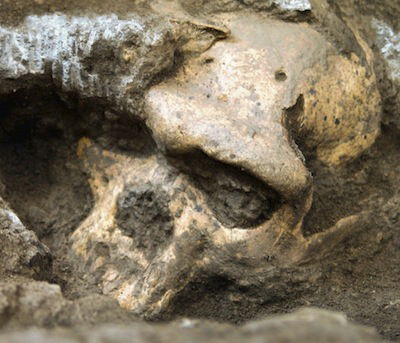
Did Skull 5 at Dmanisi belong to a human or an ape? An unusual human variation or a person suffering from disease, deficiency, or deformity? While some questions remain unanswered, only an evolutionary worldview determined to see the transitions in humanity’s supposed evolutionary origins puzzles over where to place it in the evolutionary story. Image by Georgian National Museum, via National Geographoic.3
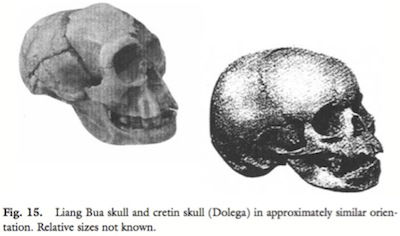
Could these microcephalic skulls—a human with a 426 cubic centimeter cranial capacity recovered from the Indonesian island of Flores (left), and a sketch of a cretin reported by Dolega in 1891 (right)—hold the key to correctly understanding the identity of the population at Dmanisi? The 1891 specimen suffers from considerably more deformity, including a mismatch between an extremely small cranium and a face with fairly large orbits and cheekbones, evolutionary anthropologist Charles Oxnard points out, but he says, “comparison of any two cretins also shows such differences.”4 So-called primitive hominid features, which may vary between individuals, may thus be nothing more than manifestations of severe disease due to a genetic problem in an isolated population or to severe iodine deficiency. Image by Charles Oxnard, via World Scientific Publishing Company.5
Mystery in the Caucasus
Lordkipanidze, now director of the Georgian National Museum, began to unearth skulls, miscellaneous human and animal bones, and simple Oldowan tools from Dmanisi in 1991. Lordkipanidze’s team suspects, based on bite marks and the way the bones are scattered, that the fossilized inhabitants of the Dmanisi Ice Age dig site were dragged into a carnivorous beast’s den and that the cave eventually collapsed, resulting in their excellent preservation.
Since their discovery anthropologists have puzzled over just which early Homo species the Dmanisi skulls represented. The first four skulls discovered at Dmanisi differed in their features and had relatively small cranial capacities ranging from 601 to 730 cubic centimeters.6 No Homo fossils then known had a cranial capacity so small, as initial Dmanisi discoveries predated discovery of the remarkably small human fossils in an Indonesian cave on the island of Flores. Originally named Homo georgicus and thought by some to bear a strong resemblance to Homo habilis, the disparate Dmanisi mix were later reclassified as variants of Homo erectus despite their small brain size. Now Skull 5, with an even smaller cranial capacity (only 546 cubic centimeters), a large jaw, and an assortment of traits considered typical of other primitive Homo species, has really confused the evolutionary picture.
Skull 5 was cobbled together from a jawbone and cranium found 5 years apart at a horizontal distance of 190 centimeters (about 75 inches) and a vertical distance of 25 centimeters (about 10 inches) from each other.7 A scattering of other bones—a humerus, clavicle, scapula, femur, tibia, and patella—were thought to probably belong to the same individual because they were found in the same region of the dig site and because arthritic changes in the knee and jaw made Skull 5 the most likely match for those particular limb bones.8 Lordkipanidze’s team thinks the two are the most likely of the bones found in the site to belong together.9 The miscellaneous mix contains no skeleton that could be definitely linked to the skulls, but it seems possible to group the bones and skulls discovered thus far as parts of “an elderly toothless male, two mature males, a young female, and an adolescent of unknown sex.”10

The five skulls found at Dmanisi do not seem to go together, having cranial capacities varying from 546 to 730 cubic centimeters and a constellation of features evolutionists typically assign to three different species of early Homo—Homo erectus, Homo habilis, and Homo rudolfensis—with the fifth skull combining the characteristics of all.They may well represent members of a post-Flood, post-Babel population suffering from disease and deprivation. Image by C. Zollikofer and M. S. Ponce de Leon / Univ. of Zurich, via NBC News.11
“Had the braincase and the face of the Dmanisi sample [Skull 5] been found as separate fossils, they very probably would have been attributed to two different species,” says University of Zurich team member Christoph Zollikofer. The Dmanisi team maintains that the tiny cranium of Skull 5—now “reunited” with a large jaw, presumably its own—and a hodgepodge of scattered human limb bones that seem to have belonged to a short person with arthritis “provides the first evidence that early Homo comprised adult individuals with small brains but body mass, stature and limb proportions reaching the lower range limit of modern variation.”12 The team attributes many of the more dramatic differences in the jaw structures of the five individuals to the impact of wear and tear on jaw morphology.13 Zollikofer says, “Together, our analyses suggest that Skull 5 and the other four early Homo [human] individuals from Dmanisi represent the full range of variation within a single species.”14
Rocking the African Cradle
Dmanisi is located in the Caucasus Mountains, far from the traditional “out-of-Africa” cradle of humanity embraced by most evolutionists. Stratigraphically, however, the excavation there involves the same geological layers in which African hominid fossils supposed to be 1.8 million years old have been found.15 Lordkipanidze and colleagues maintain that the incredible degree of variation among the five skulls in their Dmanisi collection demonstrates that all the evolutionary experiments nature was conducting at that time—such as Homo erectus, Homo habilis, Homo ergaster, and Homo rudolfensis—involved variations within one human species that evolved and was spreading out from Africa.
“Since we see a similar pattern and range of variation in the African fossil record, it is sensible to assume that there was a single Homo species at that time in Africa. And since the Dmanisi hominids are so similar to the African ones, we further assume that they both represent the same species,”16 explains Zollikofer. In the modern world, “We now have one global human species. What we can infer from our study at Dmanisi,” he says, “is that at 1.8 million years ago, there was another single global human species.”17
“Most of these [African] fossils represent single fragmentary finds from multiple points in space and geological time of at least 500,000 years,” Zollikofer says. “This ultimately makes it difficult to recognize variation among species in the African fossils as opposed to variation within species. His colleague Marcia Ponce de León indicates that fragmentary fossils, each revealing a few isolated traits, have led to an inflation of the number of Homo species in the evolutionary story. She says, “At present there are as many subdivisions between species as there are researchers examining this problem.”
Bringing Down the House
The essential question the Dmanisi collection raises among evolutionary paleoanthropologists is whether early Homo evolved once and developed variations mistakenly designated as many separate species or evolved in several different forms. Christopher Stringer of London’s Natural History Museum says, “I think they will be proved right that some of those early African fossils can reasonably join a variable Homo erectus species. But Africa is a huge continent with a deep record of the earliest stages of human evolution, and there certainly seems to have been species-level diversity there prior to 2 million years ago, so I still doubt that all of the ‘early Homo’ fossils can reasonably be lumped into an evolving Homo erectus lineage. We need similarly complete African fossils from 2 million to 2.5 million years ago to test that idea properly.”18
Fred Spoor of University College London believes the currently accepted multi-species split in the Homo fossil interpretation should stand. He says Lordkipanidze’s team failed to focus on all the details by which evolutionary paleoanthropologists define different species, such as the size of the skull openings for blood vessels. He says, “They do a very general shape analysis of the cranium which describes the shape of the face and braincase in broad sweeping terms. The problem is that those Homo species are not defined using such a broad overview of what their general cranial shape is.”19 Confirming Skull 5’s mosaic character, Spoor adds, “If I would take a saw and cut off the face and show the braincase to a colleague, I'm pretty sure that person would say, ‘That's Homo erectus.’”20 According to National Geographic’s analysis, the Dmanisi “grab bag” of features—which Spoor describes as “an interesting combination of a primitive face, primitive teeth, primitive size of the brain”—shows “evolution in action.”21
Biblical Lumping
Regardless of the different names anthropologists attach to them, the variations that developed among post-Flood, post-Babel humans were also fully human.
Lest any of our Bible-believing creationist readers be tempted to think evolutionists ought to recognize proof of Adam and Eve in the Dmanisi discoveries, let us hasten to point out that these researchers are not suggesting that humans can trace their lineage to one man and one woman. Due to their worldview, they would never admit of that possibility even if their research did demonstrate such a thing. They are as committed to the presupposition that human life evolved through random natural processes from molecules to man as we are to the presupposition that God our Creator told us the truth about our origin in His Word. Furthermore, while these researchers are scrambling the evolutionary story they don’t claim to have it all sorted out. They say that they are not even suggesting that modern humans or Neanderthals can be traced back to these particular Dmanisi varieties of Homo. Zollikofer clarifies, “We only refer to the time between 2 million and 1.8 million years ago. We are not compulsive lumpers.”22
To be biblically correct, Christians however must be “compulsive lumpers” but not in the way Zollikofer describes. According to God’s eyewitness account, He created exactly one man Adam and one woman, whom Adam named Eve. He did this about 6,000 years ago, and all people who have ever lived have descended from those two people. Thus all genuine Homo really are all of one lineage, are all fully human, and can rightly be considered Homo sapiens despite any variations that have developed in the human population in the past 6,000 years. We would not, among modern humans, think of suggesting that two people with vast differences in physical attributes belonged to different species evolving along different paths, and indeed such claims have in the past two centuries been used to “scientifically” support racism. To break up the history of humanity into multiple lineages not descended from Adam and Eve is to deny God’s Word and call our Creator a liar. In fact, Jesus Christ entered into our humanity within that lineage and shed His blood on the Cross to make salvation available for all people descended from Adam (1 Corinthians 15:45; Romans 5:12–17).
With stone tools and some clearly human bones, there is evidence of human presence in ancient Dmanisi. Based on biblical history we know that whoever (and whatever) lived there and left their mortal remains in that cave did so in the years after the global Flood. The people in the area had to be descendants of Noah’s family who ultimately dispersed from the Tower of Babel. The people whose languages God confused at the Tower of Babel and who subsequently spread out to populate the world were, like Adam and Noah, fully human. And regardless of the different names anthropologists attach to them, the variations that developed among post-Flood, post-Babel humans were also fully human.
Biblical Splitting
At the same time, in evaluating the current claims, we should keep in mind that not “everyone” called a Homo necessarily is. There are apes, and there are humans; biology has never demonstrated any evolutionary transitions, and such evolutionary claims are completely incompatible with God’s eyewitness account of our origins. But distinguishing exactly who or what a fragmentary fossil or collection of fossil fragments represents has resulted in several Homo designations that likely have nothing to do with real human history.
Biblical creationists sometimes have discussions about whether various fossil specimens are rightly considered human or ape. This primarily has occurred with very fragmentary fossils having few representatives in the fossil record and with fossil fragments that are likely lumped into mixed-species groups. Homo habilis, for instance, is a poorly defined collection of human and ape fragments. Two decades after the first H. habilis was discovered, the first example with the skull and body both present was found. That H. habilis was only an australopithecine ape. In the case of H. rudolfensis, there is even less fossil evidence. The prime specimen of H. rudolfensis consists of a toothless skull with many gaps that can be assembled to appear human or ape-like. Its body size is difficult to estimate, since there is no body to measure. In other words, there are not enough pieces to draw valid conclusions. Thus the effort to group the far more complete Dmanisi fossilized skulls and miscellaneous bones in with other alleged early Homo frankly confuses the picture even more, since at least some of “the perplexing patchwork of Homo fossils found in Africa”23 probably shouldn’t even be on the table.
So Who or What Is It?
Thus, while there is definitely a human presence evident at Dmanisi, whether all the fossil material assigned to Homo really should be is difficult to say. Though much is being made of the idea that Skull 5 is an early human of some sort with a mosaic of primitive features—an early Homo whomever—we should at least consider that, perhaps, this collection of fragmentary elements from early Ice Age (“early Pleistocene”) sediment be leftovers from some carnivorous animal’s garbage heap or debris washed into a cave from a mixture of sources.
Commenting on the discovery, Answers in Genesis anatomist Dr. David Menton, retired from the Washington University School of Medicine, emphasizes that the researchers themselves noted that the jut of the jaw, slope of the face, and the smallness of the braincase was over the top for any sort of ancient human. Without a definitive connection to an unequivocal human skeleton, or even an unequivocal connection between its own parts, the identity of Skull 5 remains up for debate.
People of Very Little Brain
Skull 5’s endocranial volume is only 546 cubic centimeters. Cranial capacity among normal humans does vary widely, with 1350 cc being the modern average, Cro-Magnon brain size being about 1600 cc, and Homo erectus being substantially smaller than that of modern humans. The low end of normal human brain capacity in modern times is represented by a mentally normal 19th century Pennsylvania Railway watchman named Daniel Lyon; the cranial capacity of this adult, measured at autopsy, was only 624 cc. Daniel Lyon could read and write and according to railway officials “there was nothing defective or peculiar about him, either mentally or physically.”24 Looking to the past, Turkana boy, an early human fossilized skeleton and skull, considered to be Homo erectus or Homo ergaster, had a cranial capacity of only 880 cc and the cranial capacity of KNM-1470 (which may be Homo erectus) is about 700 cc. In fact, though we have no people considered to be Homo erectus or Homo neanderthalensis around today, in modern people the normal variations in brain size are unrelated to intelligence. Nevertheless, the 546 cc cranial capacity in Skull 5 is, Dr. Menton points out, simply too low to be considered a normal example of Homo.
Many other features of the Skull 5 cranial/jaw combo also fail to meet normal Homo expectations. The face seems too sloped, the jaw juts too much, the nasal bones are too flat, the mandible is too big, the zygomatic arch—which makes room for powerful jaw muscles—is too capacious to be plausibly classified as a normal Homo erectus, AiG’s Dr. Menton explains. Thus, while this group of researchers is straining to impute all these characteristics to the variety of human commonly called Homo erectus, it is at least possible that Skull 5’s so-called “mosaicism” results from its mis-identification as Homo in the first place.
There is yet, however, another possibility—though it has nothing to do with human evolution! In trying to explain how at least some humans at Dmanisi had unusually small heads, we naturally think of Homo floresiensis, the human fossils colloquially known as “hobbits” found in Liang Bua cave on the Indonesian island of Flores. Because the cranial capacity measured from Homo floresiensis is only 426 cubic centimeters, both creationists and evolutionists have puzzled over how these people came to be so small. Suggestions have included severe congenital hypothyroidism (which untreated is also called cretinism), growth hormone disorders, and insular dwarfism.
Anthropologist Charles Oxnard, after surveying the skeletons of people who suffered from various forms of severe microcephaly, including iodine-deficiency–related cretinism, has made a strong though controversial case that the “hobbits” of Flores suffered from cretinism. He notes that this disorder can produce distortions in growth that evolutionary anthropologists typically consider to be primitive features found in early hominids.25 Furthermore, anthropologist Karen Baab recently noted that the Flores hominid bears a strong resemblance to the Dmanisi Homo erectus known as D2700.26 And while Oxnard’s cretinism theory remains controversial, his report of one microcephalic cretin’s skull—based on a 1891 sketch—with a jaw unusually large for the cranium27 certainly has a familiar ring when compared to the description of Skull 5’s seemingly mismatched parts. Even the usual degree of prognathism (jaw jutting) may be nothing more than a manifestation of severe hypothyroidism.28 Thus features considered “primitive” examples of “evolution in action” may well be explained as nothing more than pathological changes suffered by some isolated groups of people in the harsh post-Babel world.
Concluding Questions and Guiding Principles
Dr. David Menton, commenting on the difficulty in sorting through the data coming out of Dmanisi, says:
Ordinarily it should be simple enough to tell if a skull belonged to a human or an ape. However, this can be difficult with sparse, fragmentary specimens as we have seen before with Homo habilis and Homo rudolfensis. Furthermore, pathological changes due to disease, deformities, and prolonged deprivation can make this process difficult and present a confusing picture such as we are probably seeing at Dmanisi. I believe that some of the fossils (including limb bones) from Dmanisi are human. Whether all are, I cannot at this time say.
No doubt discussions will continue in the evolutionary community about what the Dmanisi collection means for the human evolutionary story. But frankly that entire discussion springs from the presupposition—unsupported in experimental biology—that humans somehow evolved from ape-like ancestors, whether one or many. And though we are certainly curious about the identity of the fossils at Dmanisi and what deformity or disease may have afflicted them, we do not need that information to know that all humans past and present descended from Adam and Eve without any detours through ape-like evolutionary ancestors.
Further Reading
- “The Search for the Historical Adam” and Population Genomics
- Were Cavemen Real?
- Did Humans Really Evolve from Apelike Creatures?
- Out of Asia
- Enigmatic Skull Confirmed to Have Flat Face
- Cooking: The World’s Oldest Profession
- Brainfood: Cooking
- Baraminological Analysis Places Homo habilis, Homo rudolfensis, and Australopithecus sediba in the Human Holobaramin: Discussion
For More Information: Get Answers
Remember, if you see a news story that might merit some attention, let us know about it! (Note: if the story originates from the Associated Press, FOX News, MSNBC, the New York Times, or another major national media outlet, we will most likely have already heard about it.) And thanks to all of our readers who have submitted great news tips to us. If you didn’t catch all the latest News to Know, why not take a look to see what you’ve missed?
(Please note that links will take you directly to the source. Answers in Genesis is not responsible for content on the websites to which we refer. For more information, please see our Privacy Policy.)
Footnotes
- Brian Switek, “Beautiful Skull Spurs Debate on Human History,” National Geographic, October 19, 2013, http://news.nationalgeographic.com/news/2013/10/131017-skull-human-origins-dmanisi-georgia-erectus/.
- Ann Gibbons, “Stunning Skull Gives a Fresh Portrait of Early Humans,” Science 342, no. 6156 (October 18, 2013): 297–298, doi:10.1126/science.342.6156.297.
- Switek, “Beautiful Skull Spurs Debate on Human History.”
- Charles Oxnard, “Homo floresiensis: A Very Cold Case” in his lecture series published as Ghostly Muscles, Wrinkled Brains, Heresies and Hobbits in 2008 by World Scientific Publishing Company, 320.
- Ibid., 321.
- D. Lordkipanidze et al., “A Complete Skull from Dmanisi, Georgia, and the Evolutionary Biology of Early Homo,” Science 342 (18 October 2012): 326–331, doi:10.1126/science.1238484.
- From the Supplementary Text S1 accompanying Lordkipanidze et al., “A Complete Skull from Dmanisi, Georgia, and the Evolutionary Biology of Early Homo.”
- Ibid.
- Ibid.
- Gibbons, “Stunning Skull Gives a Fresh Portrait of Early Humans.”
- Alan Boyle, “Did the Human Family Tree Just Get Simpler? Skull Stirs up Debate”, NBC News, October 17, 2013, http://www.nbcnews.com/science/did-human-family-tree-just-get-simpler-skull-stirs-debate-8C11413284.
- John Noble Wilford, “Skull Fossil Suggests Simpler Human Lineage,” The New York Times, October 17, 2013, http://www.nytimes.com/2013/10/18/science/fossil-skull-may-rewrite-humans-evolutionary-story.html.
- Ann Margvelashvili et al., “Tooth Wear and Dentoalveolar Remodeling Are Key Factors of Morphological variation in the Dmanisi mandibles,” Proceedings of the National Academy of Sciences 119, no. 43 (October 22, 2013): 17278–17283, doi:10.1073/pnas.1316052110.
- Switek, “Beautiful Skull Spurs Debate on Human History.”
- The 1.8 million year date comes from worldview-based interpretation of radiometric data and is founded on unverifiable presuppositions. To learn more see “Radiometric Dating: Making Sense of the Patterns,” “Radiometric Dating: Problems with the Assumptions,” and “Radiometric Dating: Back to Basics.”
- Melissa Hogenboom, “Blow to Multiple Human Species Idea,” BBC News, October 17, 2013, http://www.bbc.com/news/science-environment-24564375.
- Charles Q. Choi, “Oddball ‘Skull 5’ Fossil Suggests Early Humans Belonged To Same Species,” Huffington Post, October 18, 2013, http://www.huffingtonpost.com/2013/10/17/skull-5-fossil-early-humans-species_n_4117510.html.
- Ibid.
- Hogenboom, “Blow to Multiple Human Species Idea.”
- Switek, “Beautiful Skull Spurs Debate on Human History.”
- Ibid.
- Ibid.
- Gibbons, “Stunning Skull Gives a Fresh Portrait of Early Humans.”
- Based on the article B. G. Wilder “Exhibition of, and Preliminary Note upon, a Brain of About One-half the Average Size from a White Man of Ordinary Weight and Intelligence,” Journal of Nervous and Mental Diseases 38 (1911): 95–97; reported in John R. Skoyles, “Human Evolution Expanded Brains to Increase Expertise Capacity, Not IQ,” Psycoloquy 10, no. 2 (1999), http://www.cogsci.ecs.soton.ac.uk/cgi/psyc/newpsy?10.002.
- C. Oxnard et al., “Post-Cranial Skeletons of Hypothyroid Cretins Show a Similar Anatomical Mosaic as Homo floresiensis,” PLoS ONE 5, no. 9 (September 27, 2010): e13018, doi:10.1371/journal.pone.0013018; and C. Oxnard et al., “More on the Liang Bua Finds and Modern Human Cretins,” Journal of Comparative Human Biology 63 (October 27, 2012): 407–412, doi:10.1016/j.jchb.2012.09.005.
- K. Baab et al., “Homo floresiensis Contextualized: A Geometric Morphometric Comparative Analysis of Fossil and Pathological Human Samples,” PLos ONE 8, no. 7 (July 10, 2013): e69119, doi:10.1371/journal.pone.0069119.
- Discussed during a lecture series delivered at University College, London, by Charles Oxnard, published in a chapter entitled “Homo floresiensis: A Very Cold Case” in the book Ghostly Muscles, Wrinkled Brains, Heresies and Hobbits, (Hackensack, New Jersey: World Scientific Publishing Company, 2008). Reported by creationist neuroscientist Peter Line, “New Dmanisi Skull Threatens to Bring the House Down,” Creation Ministries International, October 29, 2013, http://creation.com/dmanisi.
- Evolutionist Peter Brown (“LB1 and LB6 Homo floresiensis are not modern human (Homo sapiens) cretins” in Journal of Human Evolution 62 (2012): 201–224.) does not believe the “hobbits” suffered from cretinism but notes that the sort of prognathism seen at Flores affected the full face, whereas modern adult victims of cretinism have a flatter mid-face and sub-nasal prognathism. The variety of pathological changes in the skulls of these people, regardless of the specific disease process involved, points to a very reasonable explanation for their unusual appearance.
Recommended Resources

Answers in Genesis is an apologetics ministry, dedicated to helping Christians defend their faith and proclaim the good news of Jesus Christ.
- Customer Service 800.778.3390
- © 2025 Answers in Genesis

